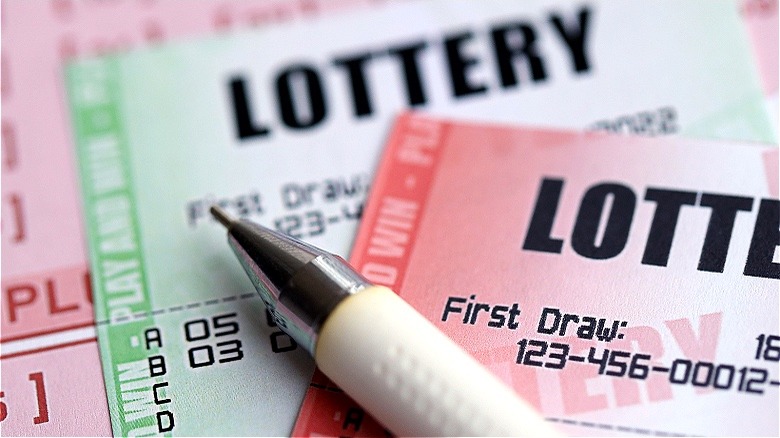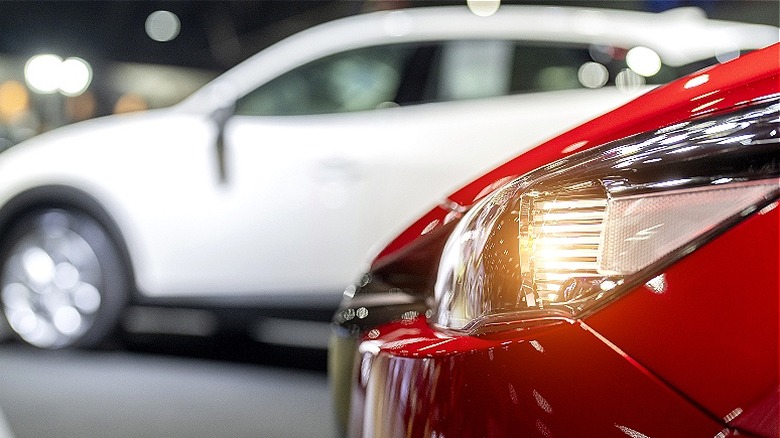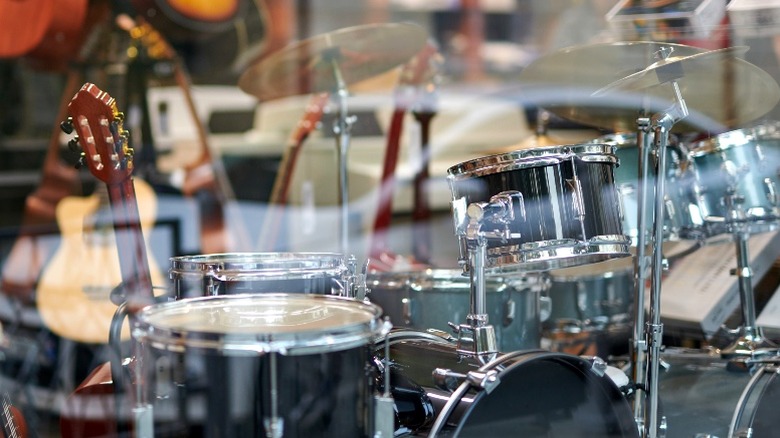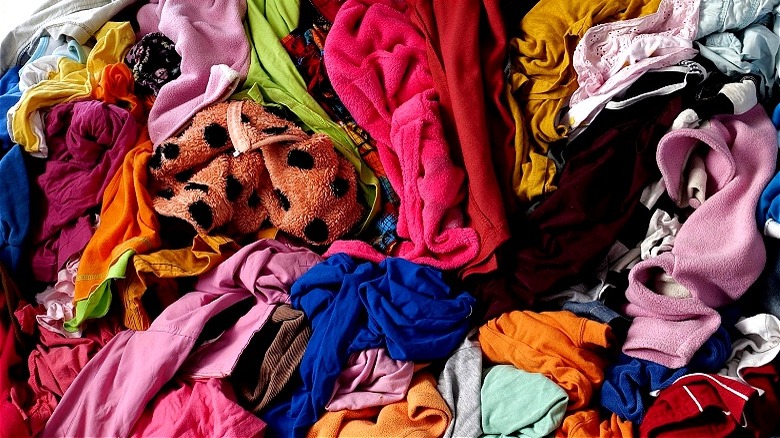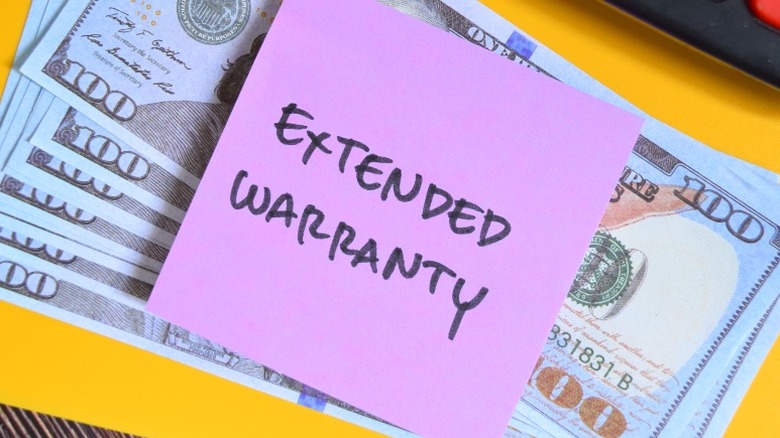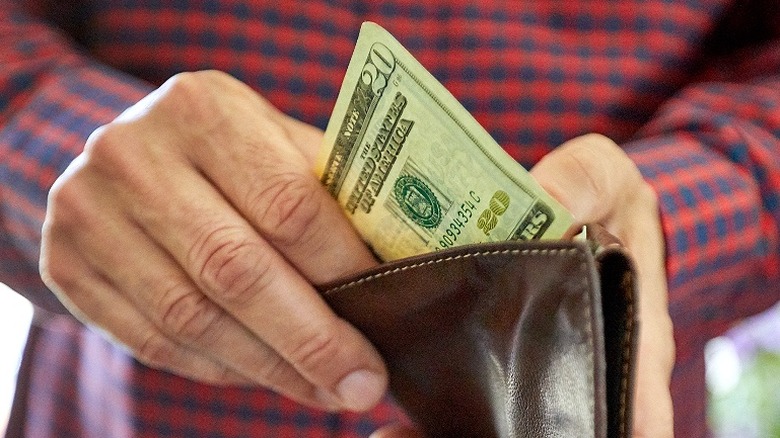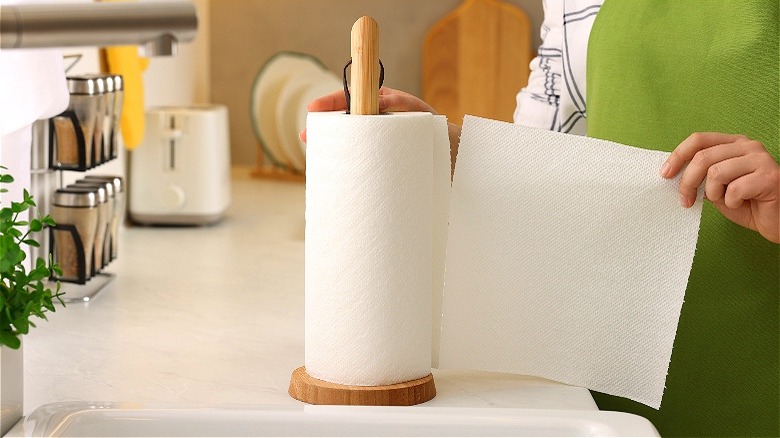12 Things Frugal People Will Always Refuse To Buy
The lifestyle of frugality is a thing that many aspire to achieve. Living frugally doesn't mean sacrificing quality of life or living on a threadbare spending schedule without any reprieve. People who practice frugality know how to make their money work for them and leverage it to the best of its ability, whether that be in a spending capacity or instead as part of a savings strategy. Frugal people put their money to work for them, earning compound interest with the help of time, but they also target key areas to use their money to purchase the lifestyle elements that matter the most to them.
In many cases, this means cutting out purchasing decisions that don't lend themselves to greater happiness, solid financial management, and future stability. The reality is that plenty of things people spend their money on are actually either somewhat wasteful or completely unnecessary. From an aversion to buying certain new items (in select categories) to warding off psychological tricks that physical and online retailers deploy to get people to spend more money, these are some of the things that frugal people simply won't pull out their wallets for.
12. Lottery tickets and scratch cards
Lottery tickets are one of the most prominent things that frugal people won't buy. Scratch cards, lottery tickets, and other gambling-adjacent purchases that fall within the same realm are a great way to waste money. The odds of winning a Powerball draw's jackpot prize are nearly 1 in 300 million, it's not an impossibility but anyone who religiously purchases lottery tickets with a true hope of taking home the ultimate prize is lost deep down the rabbit hole of delusion.
Generally, lottery tickets and scratch cards are seen in a different light than purchases fully within the aegis of "gambling." Yet, there's not much actual difference between betting on your favorite sports team and purchasing a scratch card. Both expenses lie completely out of your control and any winnings you might get back are more or less randomized. Even with the (often) false logic that sees bettors thinking they can develop a system based on statistics, gut feelings, or something else, most people involved in gambling efforts end up losing money because the house sets the odds in its favor, no matter what you bet on. Playing the lottery or frequently purchasing scratch cards is no more fruitful than betting on games, events, or intermediate outcomes. It's a great way to ultimately lose money, and for this reason frugal people won't engage in it unless it serves a larger purpose (perhaps as a fun way to add something extra to a birthday card, for instance).
11. Brand new cars
A brand new car is one of the worst purchases you can make. Frugal people understand the multiple layers of value that a car provides, but it's easy to get lost in these different layers and see a car for its flash value first and utility second. Brand new cars cost far more than a used model of the same variety. Estimates suggest that new cars depreciate at a rate of about 20% during the first year alone, meaning a one year old model could be as much as 20% cheaper than its newer counterpart. Considering that Americans drive their cars for almost 13 years before making a change, on average, this single model year difference is barely a drop in the bucket in terms of function but huge when it comes to your finances.
Your car is a means of transportation first and fashion statement later down the list. Young, single drivers who primarily need to get to and from work (alongside hobbies and activities) won't require a large or flashy ride. Families with plenty of young ones in tow will obviously need more seats, but this doesn't mean they need a more "luxurious" vehicle. A car is a tool for transportation, and spending more of your money on this purchase will only leave you hurting in other areas. This is truly one of the dumbest things to waste your money on, creating long lasting financial strain for no reason at all.
10. Homes that are larger than the budget
Everyone wants to move into their dream home. Owning a home is a goal that many young people share, but it's also an outcome that seems to be increasingly difficult to attain. House prices are ballooning in the modern marketplace, and interest rates, marketplace inventory, and other factors don't help. It can be tempting to utilize low down payment offers or chase after homes that fall just outside your budget. But without careful financial planning, the process of purchasing a home can leave you in a state known as "house poor." House poor means that you spend more money than you should on housing expenses, leaving less than you require to maintain other financial obligations. Whether this comes in the form of an intensely squeezed discretionary spending budget or an actual shortfall that affects your monthly bills, finding yourself in this position creates financial stress that makes everything in life harder.
Experts suggest that you should spend no more than about 30% of your take home pay directly on housing, be that mortgage payments or rental contributions. Any more than this figure, and you may find yourself stretching into the territory of becoming house poor, infringing on other budgetary needs in the process. Unfortunately, this isn't a problem that only affects homeowners. A renter can find themselves spending too much on housing as well, but renters have far more mobility the homeowners when it comes to remedying this issue.
9. Fully loaded cable TV subscriptions
It isn't 2005 anymore, and the television viewership wars are well and truly over. Streaming has won out over cable and satellite TV, and yet these outdated viewing models remain hulking figures in the entertainment space, retaining millions of customers across the country. There's nothing inherently wrong with cable TV but the pricing model has been totally undercut by the streaming services and alternative sources of TV and movie viewing options.
Frugal people understand that there is absolutely no reason to pay oodles of cash every month for a cable subscription service when much cheaper alternatives that still give you what you need are out there. Cord cutting has been on the rise for over a decade, with cable and satellite TV penetration in the U.S. dropping from 88% to 64% since 2010 (amounting to more than 5 million net subscribers lost). A range of streaming services now provide an a la carte viewing experience that can be tailored to an individual's unique viewing interests. More importantly, cutting the cord is a major cost-saving decision. Capital One reports that Americans spent an average of over $200 per month on cable in 2022, while Kelly Woo at Tom's Guide reported a personal savings of roughly $1,500 in just a single year after making the switch to a Sling TV service package.
8. Routine lunches at restaurants (or via delivery)
Eating restaurant-prepared meals is a great way to find yourself overspending on a regular basis. Markups on restaurant food are typically 300% over the wholesale value– sometimes more, with variations on dishes or drinks taken into consideration. In a more direct example for the consumer, research by Pamela Vachon at CNET turned up a 50% savings when preparing restaurant dishes at home and a savings of 75% when compared to popular delivery options. It can be tempting to routinely go out for lunch with coworkers or order into the office to turn their daily meal time into a more communal experience while saving a bit of time and energy outside of office hours. There is always a place for business lunches with colleagues in an effort to build rapport or maintain personal relationships. However, every time you choose to buy lunch rather than bring it with you, you aren't just making a social decision.
The financial toll of constantly choosing to go out for lunch is an intense one. With such a devastating price tag when compared against other options, this purchasing decision can severely cut into your other budgeting needs. There's no reason to cut this spending item out entirely, but a sensible approach to eating take out meals or sitting down at a restaurant is a key feature in a frugal spender's budgeting math.
7. New musical instruments
Musical instruments are perhaps a funny one here. There's something exciting, bubbly, and uplifting about wrapping your hands around a brand new guitar, saxophone, or trumpet. Fresh keys, brass, or fretboard is something to be celebrated and cherished. A new instrument can be an inspiration. But frugal players of all sorts of musical equipment know the financial and sentimental value that a used piece of gear brings to the table. They rarely buy new, unless there's a particularly good reason to.
Much like used hand tools, books, and vehicles (among others), musical instruments aren't typically something that you should buy new. Used gear will fetch a hefty price reduction, with many seeking a purchase price at least 50% off the retail cost for recently produced examples (and more for non-special issue type vintage gear; a vintage Steinway piano or 50s Gibson Les Paul will obviously build value rather than lose it). Used gear has a unique charm that's hard to pin down. The years of joy an older musical instrument has brought to the minds of previous owners and the ears of those who've had the privilege to listen lives on in the resonant tonal influences, minute chips, scratches, or dents, and the very fabric of a used instrument. These are special things, indeed, and offer both a great starting place for beginners looking to get into the art at a budget, and for seasoned players resurrecting a cherished item for their own sonic stylings.
6. Fast fashion items
The modern clothing marketplace has been totally retooled by "fast fashion." This is a trending feature of the industry that sees modern, stylish clothing produced in massive quantities and rapid timelines. The clothing rolled out is on a constantly evolving cycle in which new styles and cuts are routinely introduced, replacing older styles. Fast fashion is marked by cheap prices and often equally flimsy production. The idea is to offer buyers with plenty of choice across trending styles that won't break the bank.
However, in order for this breakneck pace of production to remain profitable, brands must constantly pump out new stuff that overtakes the existing and still perfectly great clothing already on the racks, and then get buyers to become interested in a new piece. Whether intentionally or as a byproduct, one reason why buyers of fast fashion items are continuously on the prowl for new clothing is because their existing wardrobe (filled with these items) is often overrun with what become essentially single-use pieces of clothing. The cheap price tags make a new purchase feel less harmful, but the long-term effect is anything but. Frugal shoppers instead look for quality over flash. A great pair of pants or flattering dress that can be worn numerous times without the threat of the piece falling apart provides enormous satisfaction as new memories are made in the clothing. As well, leaving behind the cycle of constantly buying new clothes will massively lift your financial standing.
5. Unnecessary use of heating or air conditioning
Paying for utilities isn't something that can generally be avoided. Critical services like heating, air conditioning, electricity, internet, and water simply must feature into a modern household's general budgetary requirements. Heating your home in the winter won't just keep you comfortable, it's essential to maintaining good health and staying on top of all the other things you have going on in your life. The same can be said for a hot home in the summer. Fighting against the health risks of living with too much heat is a serious concern for many.
This feature of frugal living doesn't focus on the day-to-day heating and cooling needs of the contemporary home. Instead, frugal shoppers will look for ways to keep their home comfortable that don't include constantly running their HVAC system—especially in the intermediate seasons that don't feature extreme weather conditions. There's absolutely no reason to blast the heat all day as soon as a slight chill enters the air, in fact, this is a great way to toss money down the drain. Instead, consider using your fireplace for a bit of cozy heat, or simply layer up for a comfortable and cost-free alternative to beating a bout of chilly air.
4. Extended warranty policies
Extended warranty policies tend to work out worse for the buyer than the insurer. Purchasing a coverage policy for your new gadget when checking out at the register is a great way to spend money on a product you're highly unlikely to actually use. For one thing, most products that include offers of a warranty policy already ship with some kind of manufacturer's guarantee that covers the general build quality that would lead to an early fault, failure, or breakage.
Moreover, when purchasing a new computer, piece of furniture, or any other product with your credit card, you're likely already buying into an extended warranty policy without having to do anything extra. Many American credit cards offer integrated coverage features that protect buyers against defects and other issues that a warranty policy would cover. This means that you don't have to add the cost of coverage to get the protection that it affords.
3. Impulse purchases at the checkout line
Both brick and mortar and online retailers try as hard as they can to get buyers to spend more money with each interaction. In the physical storefront, one way that this is accomplished is through the use of endcaps and checkout aisle displays. These sit prominently in view for buyers and often feature bright or interesting items that might act as a simple addition to your cart without breaking the bank or changing the shopping calculation all that much. eCommerce retail spaces might perform this same function with offers like free shipping or added gifts when you spend a certain amount.
Frugal shoppers understand that these traps exist and actively steer clear of them. Grocery shopping is one big area in which impulse purchases can really make a dent in your weekly or monthly budget. Adding just a few things to your shopping cart with each trip to the store can create a heavy burden on your wallet that massively adds up over time. Instead, it's important to walk into the store with a shopping list every time you pick up groceries and stick carefully to the confines of that framework. Audibles are alright from time to time, and there's always room for a change or two. However, frequently succumbing to impulse purchasing isn't the same thing. This is falling for the psychological tricks of the commercial marketplace and runs completely counter to the frugal shopping habits that many people try to exhibit.
2. Disposable paper towels
Paper towels are far more wasteful than the average consumer might realize. Single-use paper towels are massively harmful to the environment. The production of this paper product contributes significantly to global deforestation, and by extension a reduction in worldwide biomass and tree cover that help rein in the effects of global warming. Consumers concerned about the world they live in would be wise to give up paper towels based on this feature of their use, alone, but there's plenty more to raise an eyebrow. Paper towels pile up at alarming rates in landfills, and the overall waste mass they create often ends up contributing directly to methane release, further harming the environment.
The purchase of paper towel products is also a frugal shopper's nightmare. Frugal buyers often turn away from single use products with a vengeance. The ability to utilize an item just one time limits its functionality, and places a massive limit on how useful it can be in a household focused even partially on extracting financial value from purchases. Using a product even one more time functionally amortizes the cost significantly. It's for this reason that many frugal shoppers instead rely on the time honored alternative: Dish cloths and dish rags. These cotton (or other cloth material) products can be used relentlessly to clean and dry surfaces and objects in the kitchen. And, once they've served their purpose here they can be re-tasked as rags for the garage or toolbox.
1. Bottled water
Bottled water is one of the worst ways you can spend your money. The global consumer marketplace has been slowly molded by corporate conglomerates to accept the sale of this essential resource in massively price gouging packages. "Natural spring water," is a clever marketing ploy that glosses over the often public water sourced used to create the product on offer. In Vox's reporting on the bottled water phenomenon, Emily Stewart cites researcher Peter Gleick, lamenting: "We've gotten here, step by step, down a dangerous road of converting a public resource into a private commodity."
Estimates place the markup on a $2 bottle of water at 4,000%, with manufacturing costs taxing the producer at just 5 cents per unit! In 2018, consumers spent roughly $18.5 billion purchasing bottled water, with virtually the entire cost going toward the purchase of the plastic housing for this essential natural resource. Instead, frugal shoppers focus on reusable bottles, getting their water from responsible and free sources, and steering clear of big brand producers who are just gathering their product from the same aquifers, rivers, and springs that the general public can access themselves.

